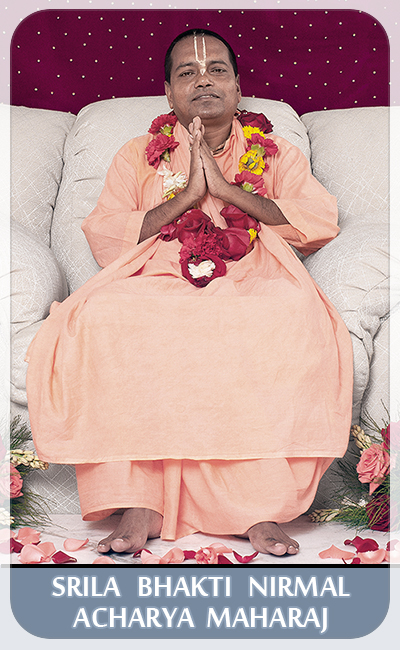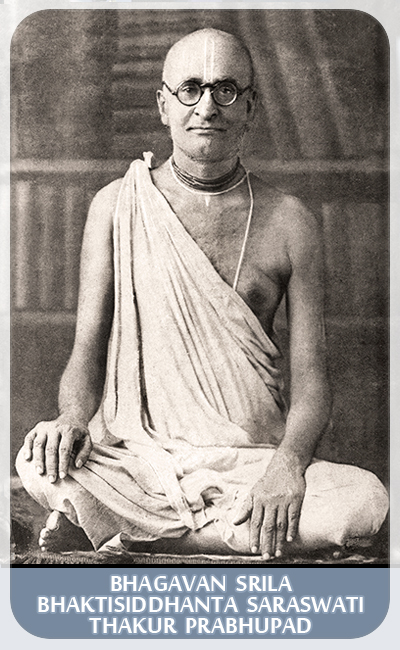Our Disciplic Succession:



|
"The Sun Never Sets on Sri Chaitanya Saraswat Math":
|
| ABOUT US | GUIDANCE | LIBRARY | DAILY PRACTICE | PHOTO | CALENDAR | CONTACT |
(10/10) Read and Learn
His Divine Grace Om Vishnupad
Srila Bhakti Nirmal Acharya Maharaj
Hooghly District, preaching programme,
20 February 2019, evening, part 10
Translated from Bengali
I have also written about householders and renounced people in Upadesh, Volume 3:
'We hear also that one revered materialist (we will not mention his name) said, "No matter how much you wash a bowl where garlic has been kept, the smell will not go away—in the same way, if a man even once regresses and goes back to live with his lawful wife, no matter how saintly he may become, the stench of his regress will never leave him."'
So, some people say that once somebody has got married, they can never become a sadhu after that. Srila Prabhupad crushed this misconception – he also gave sannyas to many householder devotees. I have also given sannyas to several people who were householders before.
Devotee: Srila Bhaktivinod Thakur was also a grihastha.
Srila Bhaktivinod Thakur did not take sannyas. He took kaupin.
'That man also advised, "A sannyasi is the one who has never once regressed and who is infallible and unblemished like a pure-blooded person born into a noble caste. Just as when you pop popcorn, all the seeds spatter and open exposing the unblemished insides; and the seeds that do not pop get stained—in the same way, no matter how chaste or devoted the householders may be, they in one way or another get 'reddish' stains, but sannyasis never get stained."'
This is all a wrong conception. Read these things carefully, then you will understand what is what. You must read it carefully, taking time to understand what is written here. The book is written in a little difficult language, but you must read it carefully.
'Srila Bhaktivinod Thakur said that in Kali-yuga, one should be a grihastha Vaishnav. One must not be afraid to fall down. Real grihasthas (householders) are not devoted to their homes—they are devoted to Krishna. Real sannyasis are those who do not renounce Krishna and kasna (servant of Krishna)—they live as members of Krishna's family, or they are attached to the house of the Lord and His devotees. There is no difference between the essence of Vaishnava grihasthas and Vaishnava sannyasis.'
Remember this. There is no difference between the essence of Vaishnava grihasthas and Vaishnava sannyasis.
I have also written elaborately about sahajiyas. '"Ami ta vaisnava" e buddhi haile amani na ha'ba ami ('আমি ত বৈষ্ণব' এ বুদ্ধি হইলে অমানী না হ'ব আমি). If I think, "I am a Vaishnav," then I will never stop expecting honour from others.' 'Grhe va vanete thake, "ha gauranga" bale dake (গৃহে বা বনেতে থাকে, 'হা গৌরাঙ্গ' বলে ডাকে).' I wrote about the internal meaning of these verses. Read what is written in this book carefully; always read it. You must read also the chapter about 'Provincialism and Service to the Lord'. I have also written here about hell. There are many kinds of hell. Many ask: is there any physical place called 'hell' or 'heaven'? Is it present in India or abroad? Are the suffering and enjoyment (happiness, opulence) that we see in this world hell and heaven? I remember reading some poems in childhood, where it is said, 'Hell and heaven are within the man; devil and god are within the man (manuser-i majhe svarga-narak, manusete surasura; মানুষেরই মাঝে স্বর্গ-নরক, মানুষেতে সুরাসুর).' This is not true! There is an actual place where hell exists. There is hell and there is heaven within the fourteen worlds of each universe. How does one get to hell? There are 120 kinds of hells. Read that chapter, and you will know about it. Read about home-interest and math-interest and apply what you read in your lives. There are also questions and answers at the end of the book. Read everything carefully.
I will not take more of your time. We will only chant a few kirtans now. Today is our first day here, I know you have taken great trouble to come from far. Tomorrow, the programme will be at Kartik Prabhu's house. Let us chant some kirtan now and I will finish then.
[His Divine Grace chants 'Emona durmati', 'Hari Haraye Nama', the Hare Krishna maha-mantra and then concludes the evening programme.]
— : • : —
| ◄ | ► |
{ 2001 |
2002 |
2003 |
2005 |
2009 |
2010 |
2011 |
2012 }
{ 2013 |
2014 |
2015 |
2016 |
2017 |
2018 |
2019 |
2020 |
2021 }
CLICK TO LISTEN TO THE LECTURE
Size: 29 Mb
Length: 60 min
Language: Bengali
READ OTHER PARTS:
1)
Sadhus' Approach
2)
Help Yourself and
Others
3)
Wasteful Living, Low
Thinking
4)
Immerse Yourself in
Service
5)
Clear-Cut and
One-Pointed
6)
Sincere Devotion
7)
Hari-Kirtan Adhikar
8)
Devotion to Gopis
9)
Student Means Studying
10)
Read and Learn
| Heartfelt and Fervent |
|---|
| 'Even two trees can get Your lotus feet, can get mercy from You, Prabhu! But I am even lower than that, I have no devotion, but You can rescue me..' |
 |
“Big-big Vaishnavs have the power to digest anything, but we are practitioners...” |  |
Sitemap | Contact us | About us
